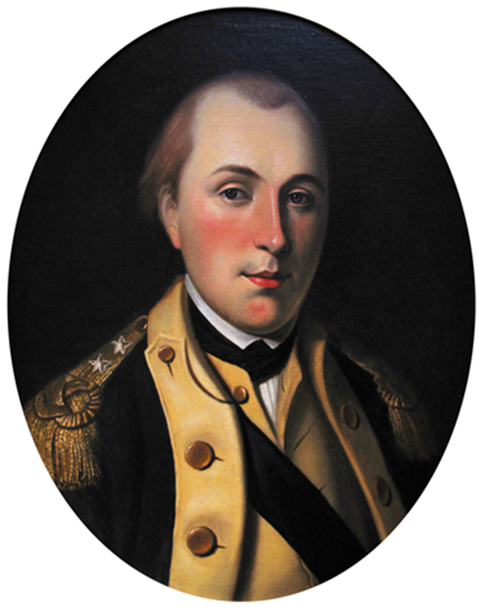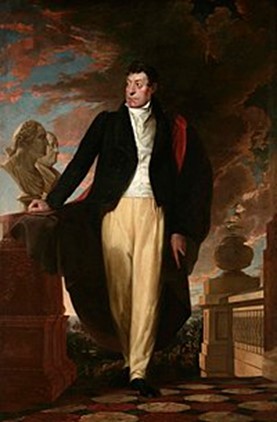The Marquis de Lafayette was a hero to most Americans. He was 19 years old when he came to the colonies in 1777, at his own expense, and joined the Continental Army in its fight for independence. A close friend of General Washington, Lafayette commanded troops in several battles, helped persuade King Louis XVI to send troops and supplies to help the colonists, and was at the siege of Yorktown in 1781.
As the last surviving Major General of the Revolutionary War, Lafayette was invited by U.S. President James Monroe and Congress to visit the 24-state Union for what would become his Farewell Tour in the United States of America. Accompanied by his Secretary Auguste Levasseur, General Lafayette visited all twenty-four states of the Union in 13 months (August 1824 – September 1825).
While almost 50 years had elapsed since the end of the Revolutionary War, the presence of General Lafayette in the United States unleashed a burning desire to express the peoples’ gratitude that had been building during the postwar period.1
On September 22, 1824, Attorney James Hamilton, Jr., and Edward J. Stiles of Carlisle had the honor of waiting upon General Lafayette at the State House in Philadelphia. They presented him with resolutions from the town, and accompanied by a short address invited him to visit Carlisle if his schedule permitted. “The General expressed his gratitude to the citizens of Carlisle for their good wishes, and the great pleasure it would afford him to visit Carlisle should his engagements permit and promised an early answer to the Resolutions of the Town Council.” 2
Earlier that month, in hopes of a visit from General Lafayette, the Corporation of the Borough of Carlisle, and the surviving soldiers of the Revolution, called a meeting of the citizens of Cumberland County for Saturday, September 4th at the County Hall “for the purpose of expressing to the youthful hero in our struggle for Independence…the guest of our country, Gen. Lafayette, our gratitude for his former services…”3The meeting at the court house was convened by Captain John Underwood, a soldier of the revolution, Colonel William N. Irvine, Vice President, and Capt. Samuel Alexander, Secretary. It was resolved that the president of the Town Council [James Hamilton, Jr.] appoint a committee of seven persons to draft a “resolution expressive of the sense of this meeting to be presented to our NATION’S GUEST, General Lafayette.” The men were appointed, and after a short adjournment reported a preamble and resolution which were unanimously adopted. After they were read to the public, the committee was directed to present them to General Lafayette and invite him to visit the county.
Two days later, on September 6, the members of Town Council of Carlisle met in the Town Hall and unanimously agreed to the Resolutions and the invitation to visit Carlisle. They resolved that the Rev. Alexander McClelland (Acting President of Dickinson College), Mr. Edward J. Stiles, John D. Mahon, Esq. and James Hamilton, Esq. be requested to wait on and communicate the resolutions to General Lafayette, and that the editors in Carlisle were requested to insert the resolutions in the respective papers.4
The closest Lafayette got to Carlisle was Harrisburg, Pennsylvania on January 30, 1825. Although Lafayette never visited Carlisle, we can imagine what it would have been like from a description of his visit to Lancaster, Pennsylvania in July 1825. The committee that was appointed to meet and escort Lafayette from the border of Chester County to Lancaster set “out in three elegant barouches, each drawn by four fine horses, out-riders, a carriage intended to carry the attendant of the General, his baggage, etc. One barouche was drawn by four dapple grey horses, a second one drawn by four bays, and a third drawn by four white horses. When they reached the county line, a “vast concourse of citizens, [and] two fine troops of horse…” were waiting to greet the General. After a calvary salute, General Porter gave a welcoming speech to Lafayette.
Following that, the cavalry escorted him to a hotel where the General alighted, greeted everyone and took refreshment. Then, it was back into the barouches and on to the next stop in Paradise, Lancaster County, where the General halted for a few minutes to talk to General Witmer.
Finally, at 20 minutes to 4 o’clock, he arrived about two miles from Lancaster. Waiting to greet him was an immense crowd of people, lines of volunteers from local militia battalions, guards, associations of carpenters, youths, young men with badges, farmers, troops of citizens, etc. After the military saluted the General, he got into a barouche led by a procession, and at 5:30 o’clock entered the city of Lancaster. It was almost 7 o’clock when he arrived at Slaymaker’s Hotel where a reception was being held. He was greeted by the Mayor, the Recorder, the Aldermen, and the Councils. The Mayor gave a speech and Lafayette graciously replied. Then the General and his suite were introduced to all the men present, and at 8 o’clock they were finally able to sit down for dinner.
The next morning, Lafayette was greeted by the clergy of the city who gave an address to the General. He was then introduced to Revolutionary War soldiers and various citizens. At 11 o’clock he was taken to visit the Lancastrian School where he was met by all the teachers and their pupils. The boys were wearing blue sashes and holding bunches of laurels. The girls were wearing pink sashes over their white dresses, and each girl held a bouquet of wildflowers. A white banner bearing the names of WASHINGTON, LAFAYETTE, FRANKLIN, and PENN was displayed by the children on each side of the room. The windows were festooned with evergreens. When the General reached the door, everyone rose and sang to him. He took his seat on the platform, and a young boy came up and read a composition that he had written. The General addressed the crowd and thanked them for their welcome. The music struck up “Lafayette’s Welcome,” the children waved their flowers, Huzzahs were shouted, and tears were shed by many in the crowd.
After addresses at the school, the General left to visit his old friend George Ross, Esq., and the sister of his friend General Hand. On the visits went, all day. At 4 o’clock the General and his suite were accompanied to an upper room in the Court House where he was greeted by officials and about 150 people before they sat down to a “sumptuous dinner.” Toasts followed, and at 8 o’clock the General visited several people before attending a party at the Masonic Hall. At 10 o’clock the General retired for the night.5 He left Lancaster at 6 a.m. the next morning to do it all over again in another town. That was just one visit to one town in one of the twenty-four states he visited on his 13-month tour.

